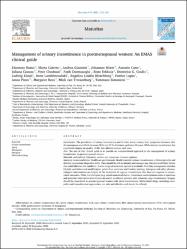| dc.contributor.author | Russo, Eleonora | |
| dc.contributor.author | Caretto, Marta | |
| dc.contributor.author | Giannini, Andrea | |
| dc.contributor.author | Bitzer, Johannes | |
| dc.contributor.author | Cano, Antonio | |
| dc.contributor.author | Ceausu, Iuliana | |
| dc.contributor.author | Chedraui, Peter | |
| dc.contributor.author | Durmuşoğlu, Fatih | |
| dc.contributor.author | Erkkola, Risto | |
| dc.contributor.author | Goulis, Dimitrios G. | |
| dc.contributor.author | Kiesel, Ludwig | |
| dc.contributor.author | Lambrinoudaki, Irene | |
| dc.contributor.author | Hirschberg, Angelica Linden | |
| dc.contributor.author | Lopes, Patrice | |
| dc.contributor.author | Pines, Amos | |
| dc.contributor.author | Rees, Margaret | |
| dc.contributor.author | van Trotsenburg, Mick | |
| dc.contributor.author | Simoncini, Tommaso | |
| dc.date.accessioned | 2021-01-15T07:51:32Z | |
| dc.date.available | 2021-01-15T07:51:32Z | |
| dc.date.issued | 2021 | en_US |
| dc.identifier.citation | Russo, E., Caretto, M., Giannini, A., Bitzer, J., Cano, A., Ceausu, I. ... Simoncini, T. (2021). Management of urinary incontinence in postmenopausal women: An EMAS clinical guide. Maturitas, 143, 223-230. https://dx.doi.org/10.1016/j.maturitas.2020.09.005 | en_US |
| dc.identifier.issn | 0378-5122 | |
| dc.identifier.issn | 1873-4111 | |
| dc.identifier.uri | https://dx.doi.org/10.1016/j.maturitas.2020.09.005 | |
| dc.identifier.uri | https://hdl.handle.net/20.500.12511/6256 | |
| dc.description.abstract | Introduction: The prevalence of urinary incontinence and of other lower urinary tract symptoms increases after the menopause and affects between 38 % and 55 % of women aged over 60 years. While urinary incontinence has a profound impact on quality of life, few affected women seek care. Aim: The aim of this clinical guide is to provide an evidence-based approach to the management of urinary incontinence in postmenopausal women. Materials and methods: Literature review and consensus of expert opinion. Summary recommendations: Healthcare professionals should consider urinary incontinence a clinical priority and develop appropriate diagnostic skills. They should be able to identify and manage any relevant modifiable factors that could alleviate the condition. A wide range of treatment options is available. First-line management includes lifestyle and behavioral modification, pelvic floor exercises and bladder training. Estrogens and other pharmacological interventions are helpful in the treatment of urgency incontinence that does not respond to conservative measures. Third-line therapies (e.g. sacral neuromodulation, intravesical onabotulinum toxin-A injections and posterior tibial nerve stimulation) are useful in selected patients with refractory urge incontinence. Surgery should be considered in postmenopausal women with stress incontinence. | en_US |
| dc.description.sponsorship | Sistema de Investigacion y Desarrollo (SINDE) ; Vice-Rectorado de Investigacion & Postgrado (VRIP) of the Universidad Catolica de Santiago de Guayaquil, Guayaquil, Ecuador (The Omega II, Women's Health Project) | en_US |
| dc.language.iso | eng | en_US |
| dc.publisher | Elsevier Ireland Ltd | en_US |
| dc.rights | info:eu-repo/semantics/embargoedAccess | en_US |
| dc.subject | Urinary Incontinence | en_US |
| dc.subject | Aging | en_US |
| dc.subject | Menopause | en_US |
| dc.subject | Estrogens | en_US |
| dc.subject | Midurethral Slings | en_US |
| dc.title | Management of urinary incontinence in postmenopausal women: An EMAS clinical guide | en_US |
| dc.type | article | en_US |
| dc.relation.ispartof | Maturitas | en_US |
| dc.department | İstanbul Medipol Üniversitesi, Uluslararası Tıp Fakültesi, Cerrahi Tıp Bilimleri Bölümü, Kadın Hastalıkları ve Doğum Ana Bilim Dalı | en_US |
| dc.authorid | 0000-0003-4067-7887 | en_US |
| dc.identifier.volume | 143 | en_US |
| dc.identifier.startpage | 223 | en_US |
| dc.identifier.endpage | 230 | en_US |
| dc.relation.publicationcategory | Makale - Uluslararası Hakemli Dergi - Kurum Öğretim Elemanı | en_US |
| dc.identifier.doi | 10.1016/j.maturitas.2020.09.005 | en_US |
| dc.identifier.wosquality | Q1 | en_US |
| dc.identifier.scopusquality | Q1 | en_US |


















